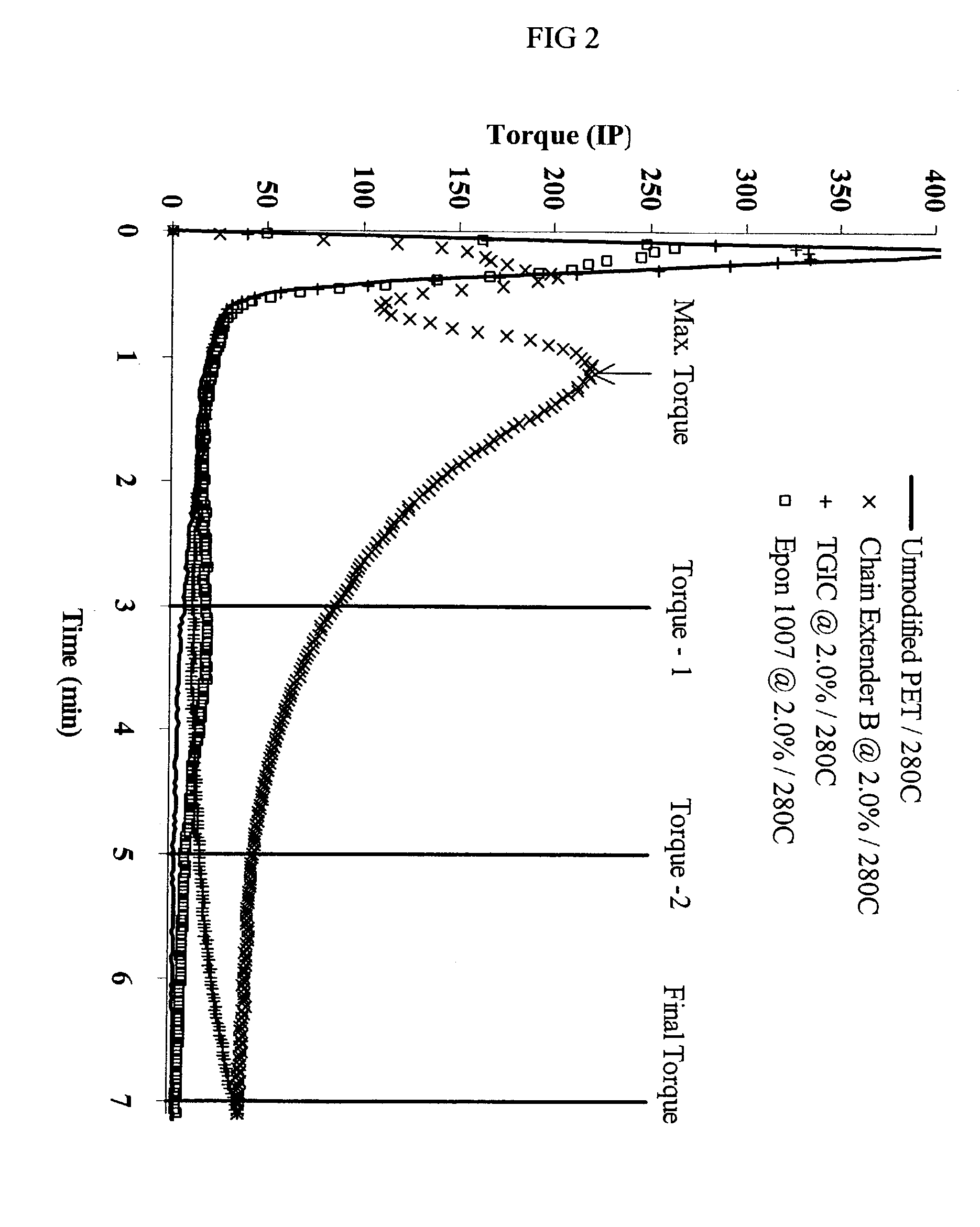Oligomeric chain extenders for processing, post-processing and recycling of condensation polymers, synthesis, compositions and applications
a technology of extenders and condensation polymers, applied in the direction of coatings, etc., can solve the problems of affecting the mechanical, thermal, rheological properties of materials, and the degree of polymer molecular weight degradation, so as to increase the molecular weight of condensation polymers, shorten the residence time, and improve the effect of molecular weigh
- Summary
- Abstract
- Description
- Claims
- Application Information
AI Technical Summary
Benefits of technology
Problems solved by technology
Method used
Image
Examples
example 1
[0069]Virgin PET of Intrinsic Viscosity (I.V.)=0.75 dL / g (Eastapak 7352 from Eastman Chemicals) was processed through a single extrusion step with and without the use of a chain extender. The extruder employed is a 30 mm, twin-screw, with 5 temperature zones plus die, operating at T1 to Tn=280° C., and 200 RPM. The PET was used without pre-drying, no vacuum was employed during processing, and no catalyst was employed.
[0070]Three chain extenders of this invention designed and prepared according to the process described above were evaluated at different loads against a large number of leading chain extenders known in the art. In each case the given amount of chain extender was pre-mixed by dry blending to homogeneity with the PET pellets before the mix was fed at constant rate into the extruder.
[0071]The I.V. results of the final compounds are given in Table 2 below. The PET undergoes a marked molecular weight degradation during the prescribed processing step starting from an I.V. of ...
example 2
[0076]Virgin PET of Intrinsic Viscosity (I.V.)=0.75 dL / g (EASTAPAK™ 7352 from Eastman Chemicals) was processed through a single extrusion step with and without the use of chain extender. The different zone and die temperatures and extruder RPM's were adjusted to maximize the I.V. of the product and are shown in Table 3 below.
[0077]In this case the PET was pre-dried from an initial moisture value of 0.0947% to a final value lower than the detection limit of the equipment. No vacuum was employed during processing, and no catalyst was employed.
[0078]Three chain extenders of this invention were evaluated at 2% w / w against the current art chain extender showing best performance in example 1. In each case the given amount of chain extender was pre-mixed by dry-blending to homogeneity with the PET pellets before the mix was fed at constant rate into the extruder.
[0079]The Intrinsic Viscosity (I.V.) results of the final compounds are given in Table 3 below. Notice the marked molecular weigh...
example 3
[0082]Virgin PET of Intrinsic Viscosity (I.V.)=0.83 dL / g (MELINAR™ Laser C B95A, DuPont Chemical Company) was processed using a Brabender Plasti-Corder. The PET was processed for 10 minutes at temperatures of 260° C. and 280° C. and at a constant speed of 50 rpm. The PET was used without pre-drying, catalyst, or vacuum during processing.
[0083]Three chain extenders of this invention (B, D, and E) designed and prepared according to the process described above were evaluated at two temperatures (260° C. and 280° C.) and two levels (0.5 and 2.0% as w / w in mix). In each case the given amount of chain extender was pre-mixed to homogeneity with the PET using a Strand Mixer before the blend was fed into the mixing chamber. Examples of torque vs. time traces are shown in FIG. 1. Values of interest are maximum torque following melting (Max. Torque, Inch Pounds—IP), time to maximum torque, and torque at three (Torque-1), five (Torque-2), and seven minutes (Final Torque). In this set of experim...
PUM
| Property | Measurement | Unit |
|---|---|---|
| polydispersity index | aaaaa | aaaaa |
| weight percent | aaaaa | aaaaa |
| weight percent | aaaaa | aaaaa |
Abstract
Description
Claims
Application Information
 Login to View More
Login to View More - R&D
- Intellectual Property
- Life Sciences
- Materials
- Tech Scout
- Unparalleled Data Quality
- Higher Quality Content
- 60% Fewer Hallucinations
Browse by: Latest US Patents, China's latest patents, Technical Efficacy Thesaurus, Application Domain, Technology Topic, Popular Technical Reports.
© 2025 PatSnap. All rights reserved.Legal|Privacy policy|Modern Slavery Act Transparency Statement|Sitemap|About US| Contact US: help@patsnap.com


